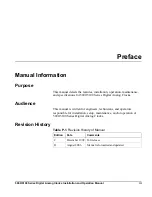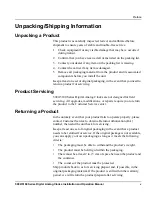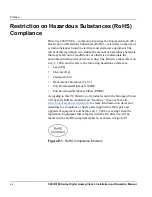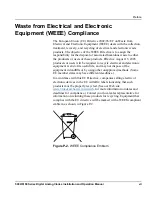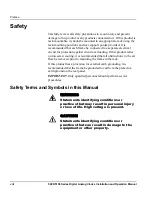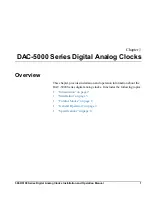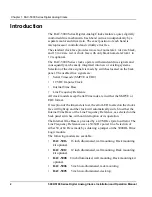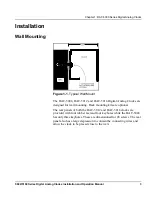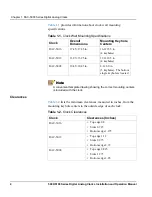
5000/5100 Series Digital Analog Clocks Installation and Operation Manual
9
Chapter 1: DAC-5000 Series Digital Analog Clocks
General Operation
Clock Control Modes
Primary Reference Mode
The Primary Reference Mode provides two options, the Timecode and
the Impulse Clock modes. Selection of either mode is done by switch
SW1.
Timecode Mode
No setting of time is required when the timecode mode is selected.
However, selection of either SMPTE or EBU format should be made by
means of switch SW2.
Upon selecting Timecode mode, the microprocessor will start reading
the code and will light the error LED of the clock face (found under the
6) to indicate that the unit is not yet synchronized with the timecode.
Once the timecode is decoded, the clock hands will move in a clockwise
direction towards the 12:00 position where the three hand detectors are
located. The clock hands will then move to their new position via the
shortest route and the error LED will go off to indicate that the unit is
synchronized with the timecode.
If there is a change in the timecode, the error LED will activate again
while the microprocessor verifies the code to ensure that there is a valid
time change and not a transient condition. This verification requires 30
consecutive full code frames or 1 second for SMPTE format operation,
and 1.2 seconds for EBU format, depending on the selection of switch
SW2. Once the verification is completed and if there is a valid change,
the clock hands will move to the new time position as previously
described and the error LED will go off.
If the timecode is lost due to a mechanical failure such as a
disconnected cable or to a malfunction of the master clock, the error
LED will light up again. The clock, however, will continue to operate
and show accurate time since it will automatically switch to the
secondary time base selected by switch SW3 (either the line frequency,
or the internal crystal oscillator). Once the malfunction is eliminated the
clock will automatically switch back to timecode and re-synchronize to
the incoming timecode, and the error LED will go off.

